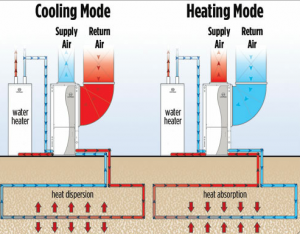 In this week’s column I will be looking at geothermal heat pumps—how they work, what are their strong points and drawbacks, and which companies are industry leaders.
In this week’s column I will be looking at geothermal heat pumps—how they work, what are their strong points and drawbacks, and which companies are industry leaders.
First off, how do heat pumps work in general and what exactly is a geothermal heat pump? Heat pumps are commonly used for heating and cooling houses in temperate climate regions of the United States. The concept behind heat pumps is actually pretty simple. Heat pumps are made up of two units—an outdoor unit (the condenser) and an indoor unit (the evaporator coil)—with refrigerant carrying the heat from one area to the other. The key concept of a heat pump is that the refrigerant absorbs and releases heat depending on the relative temperature and pressure of the liquid. As refrigerant goes from a high-pressure, high-temperature state to a low-pressure, low-temperature state, it can absorb heat. In the wintertime the heat pump is able to extract heat from the outdoor air and use it to heat a home (even cold air contains a great deal of heat though heat pumps work best in areas without temperature extremes). In the summertime the process is reversed thus providing cool air.
A geothermal heat pump works on the same principle as a conventional heat pump except that the coils, rather than being exposed to the air, are buried under the ground and therefore the heat exchange takes place between the ground (vice air) and the heat pump coils. The coils can be laid out in the earth in several different configurations depending on the amount of land available. As ground temperature stays relatively constant throughout the year, this makes the geothermal heat pump an excellent heat exchanger compared to traditional heat pumps, which become less efficient outside of temperate climates.
Because the ground temperature is relatively constant and temperate, it allows efficiencies; geothermal heat pumps use significantly (25%-50%) less electricity than conventional heating or cooling systems, resulting in significant saving to the homeowners and businesses. Also, as geothermal heat pumps have few moving parts they are durable and highly reliable. However, high capital costs incurred during initial setup constrain growth of geothermal heat pumps. Of course, their overall economic benefit depends primarily on the relative costs of electricity and fuels, which are highly variable over time and across the world.
The geothermal energy industry benefits from a 30% uncapped tax credit available to U.S. homeowners and businesses that install geothermal heat pump systems, partially defraying high initial installation costs. This credit is due to expire in 2016. Also the industry has seen an increasing interest in geothermal heat pumps from mainstream dealers and distributors.
The geothermal heat pump industry faces several challenges going forward. One major challenge is the depressed market for new residential housing. Fewer new houses mean fewer heat pumps to install, though this decrease has been partially offset by an increase in conversions from conventional to geothermal heat pumps. In addition, demand for the industry’s products fluctuates with fuel costs. With their rather substantial installation costs, geothermal heat pumps are more attractive when fuel costs are high while low fuel costs makes them less so.
One of the leading companies in the geothermal heat pump industry is Canadian firm WaterFurnace Renewable Energy, Inc. (WaterFurnace), which trades on the Toronto Stock Exchange under the symbol WFI. WaterFurnace is more of a pure play on geothermal heat pumps and currently sports a 5.6% dividend. Its major competitor is LSB Industries Inc. (NYSE: LXU), which is more diversified, specializing in geothermal and water source heat pumps, air handling products, and chemical products. In summary, the future for geothermal heat pumps seems bright though both companies’ long-term success will be closely tied to the recovery of the housing market.
Disclaimer: This article is intended to be informative and should not be construed as personalized investment personalized advice. You are responsible for your own investment decisions.
Disclosure: The author has no position in WaterFurnace or LSB Industries and no plans to initiate a position in the next 72 hours.
[Image]

